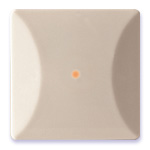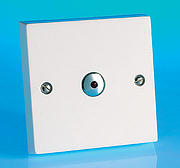home :: ha :: intelliswitch
We didn't think much about lighting when our house was being built, so
it ended up being fitted out by the builder just like every other new
home with standard white plate light switches. The lights themselves
however were all the recessed R50 spotlight types. We went through
a variety of different ideas for lighting control before settling on
using "Intelliswitch" switches for the majority of the house.
When thinking about home automation most people assume that this includes
having all your lighting under direct control of some computer system. You
can then control everything from a central point, do cunning scene lighting,
and magically turn on and off lights during the day. Since our house was
already wired up and we didn't fancy rewiring to install any of the number
of lighting solutions available this left us with a difficult problem.
X10 lighting
X10 devices are commonly used to control things like lighting and
lamps because they don't require any rewriting. You can simply use
plug adaptors or light switch replacements and the devices communicate
over the power lines. So our first experiment was using X10 for
lighting control.

LW10 UK light switch
The switch most commonly used for this is the LW10 which can turn
lights on and off, dim them, and be controlled by the X10 protocol
from other things. We didn't much like the look of the LW10; it's
chunky, sticks out of the wall, and according to folks on various X10
forums constantly blows fuses. Perhaps the biggest problem with the
LW10 is that you can't remotely tell it to go to a discrete dim level.
You can't say "Dim to 50% brightness", only "Dim by X steps". Since
we wanted to do scene lighting this was far from ideal. Also in the UK
these things are quite expensive; you don't get much change out
of UKP30 per unit.
On the continent the X10 light switches are much better, having
the ability to dim to a discrete level and looking a lot more classy.
They do need to have a neutral wire at each switch socket to function
though, which is not common in the UK. Fortunately when our house
was built the electricial wired a neutral to every socket. We think
this was to save having to use connectors inside the ceiling as
spotlights were being used, but we'll probably never know for sure.
Anyway this was good news for us:

LW11 German light switch
So we bought one from Laser and
put it in the living room, controlling 10 25W R50 spotlight bulbs.
We can't fault the function of this switch, it works reliably and we
can set the level remotely, or using a remote control with a IR X10
receiver in the same room. However these things are designed to
be fitted to continental backboxes and it never really looked
in place. See a picture of the lw11 in the
living room. We couldn't put the right switch rocker in because
the switch is slightly twisted and it just constantly catches on
the edges stopping it from working reliably. Also these switches
are a bit more expensive than the UK LW10.
Just dim it
Another problem we had in the house was over-voltage which
dramatically cut the life of the expensive spotlight bulbs. Actually
the only place where the life of the bulbs was not affected was in
the en-suite bathrooms which we had fitted with touch switches we'd
bought from somewhere like Argos. These touch switches were white,
had a LED in the centre, and allowed you to turn lights on and off
(and critically for the ensuite allowed the lights to turn themselves
off after some number of minutes). These switches also had a soft
start which we figured was mostly responsible for the increased
lamp life.

Touch switches in the ensuites
So we decided that dimmers were the solution for rooms where we
didn't need automatic control of lighting. The big blocky white
switches from Argos were not really approriate for the look of the
house. We looked around and found some amazingly nice looking dimmers
that also were able to be controlled by infrared. We bought a
few of these from TLC and installed
them in the kitchen and bedrooms.

Cute IR touchswitches
Unfortunately it wasn't long before the first switch stopped working with
a burning smell from inside it. A month or so later the second switch
stopped working in an identical way. We gave up and sent the switches back,
perhaps they didn't like the high voltage in the house, they certainly
were not overloaded.
So by now we'd figured out that we didn't really need to be able
to control every light in the house and in fact just the main living room
lights made sense to control and dim for watching movies and so on. We
also figured out that we really needed to use dimmers with a soft-start
function to help prolong the life of the bulbs.
Back to where we started
I don't know how we found it, but the touch switches we had installed
in the ensuite bathrooms were made by a company called "Touch'n'glo"
in the UK. Hunting around google we found a web site for them, selling
a range of "Intelliswitch" dimmers. The basic dimmer allowed you to
touch the light switch to turn the light on and off and hold it down to
dim. They were available in some lovely brushed metal finishes,
had switchable colour covers to blend into the decor of the rooms, were
not too expensive, and just looked perfect.
We chatted to their sales director and found out that the switches
were designed and built in the UK and that they would soon also be available
with slaves (for two or three way lighting like on our landings) and
as multiple gang switches where you want to control more than one light
from the same place. Perfect! We promised to write up a review of the
switches and ordered about 10 of them with a slimline brushed
stainless steel plate.

Brushed slimline
stainless steel dimmers
Mini review: Intelliswitch dimmers
The web site does a
good job of explaining how these work and it's really as simple as
it looks - replacing all ten of the light switches took only an hour
or two and it took us longer to decide what colour inserts to use in
each switch I think. The only difficulty during installation is
making sure that you have the load and supply leads correct - the
way our switches had been installed it was impossible to tell from
inspection and we had to rely on a voltage meter (and careful fingers!).
We've been using them now for around nine months without a single
incident, including dimming of some mains halogen GU10 fittings. The
switches just work, look great, and visitors always admire them. Some
of the switches have a slight humming noise when they are on which you
can hear when very close to the switches, but that is something you'd
find with any dimmer working in the same way.
So what are the downsides? to me the only real downside is that
they're not computer or even infrared controllable. The geek in me
wants to be able to control them remotely. If these things were X10
compatible those horrible white expensive X10 switches would be left
on the shelves forever. You can now get RF switches that don't
require rewiring that give you computer control, but they can cost
five to ten times the price, per switch, so it's not very economical.
These intelliswitches are around the same price as you'd buy a
standard metal wall switch from some large DIY chain.
Okay, there is one more downside that I wasn't expecting. I was
waiting for the Intelliswitch folks to release their 2-gang and slave
versions of the switch so I could finish converting all the switches
in the house. At the moment you walk in and see a hallway with
two nice brushed stainless steel switches, and one horrible white
place hall light switch. About half the switches in the house need
the 2-gang or slave versions. Originally I was expecting these
to be available in Spring 2004, but we're not into October and
they are not available. Intelliswitch didn't reply to my mails, or
phone calls with expected dates, and their web site has been
broken now for a number of months. Companies house still shows
Touch'n'glo as as existing. I do hope the company underneath
is okay, these switches simply rock.
Intelliswitch in the office
Created: 08 Oct 2004
|